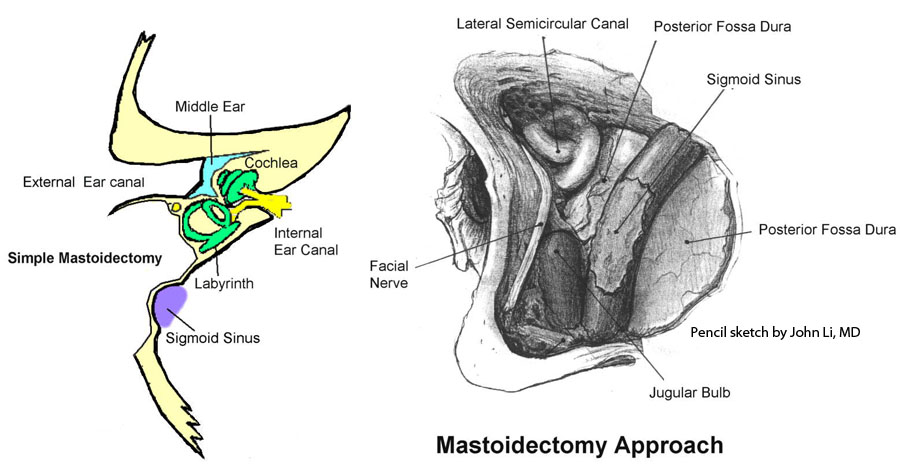


JOHN LI, M.D.
OTOLOGY NEUROTOLOGY RESOURCES
210 Jupiter Lakes Blvd #5105
Jupiter, FL 33458
Phone: (561)-748-4445
Fax: (561)-748-4449
Email: Dr-Li@Dr-Li.net
Mastoidectomy
Patient Information on Mastoidectomy
Mastoidectomy is an operation to gain surgical access behind the ear. This can be done as part of treatment for mastoiditis, chronic suppurative otitis media or cholesteatoma. In addition, it is sometimes performed as part of other procedures (cochlear implant) or Envoy Esteem surgery.
Some General ENT doctors do not do Mastoidectomy because of the daunting surgical riskiness, and refer these case to to Dr. Li.

Although complications do not often occur, they include persistent ear drainage, infection in the mastoid cavity and hearing loss. Facial nerve injury (paralysis of the face on the side of the surgery) is a rare but potential hazard in mastoid surgery. There may be dizziness for a short time after surgery, but it is rarely permanent. Loss of taste on the side of the tongue usually lasts a few weeks but may be permanent.
Indications
1. History... one or more required
a) Postauricular periosteal swelling or pain unresponsive to medical treatment.
b) Infected drainage from the ear unresponsive to medical treatment.
c) Planned second look for intact wall mastoidectomy.
d) Persistent middle ear disease unresponsive to management.
e) Fullness in the ear, hearing loss or pain.
f) Approach to failed tympanoplasty.
g) Evidence of chronic disease in patient who may not be aware of a problem such as retraction pockets with squamous debris, cholesteatoma, mucous crusts from non-infected discharge, and glomus tympanicum.
2. Physical Examination (required)
a) Complete bilateral description of ear canal, tympanic membrane, postauricular area (if abnormal), facial nerve function and description of nystagmus (if present).
b) Evaluation of middle ear.
3. Tests
a) Audiometry-pure tone and speech bilateral.
b) Imaging-Mastoid X-Ray or CT scan.
See Post Op instructions here.
Ossiculoplasty
Ossiculoplasty involves reconstruction of the hearing bones (ossicles). When hearing bones are eaten away by tumor, they can be replaced with natural (carved from the broken incus) or synthetic bones. These replacement bones need to be placed in proper alignment to conduct sound to the inner ear.
The most frequently damaged hearing bone is the incus. However, the other bones may be involved. There are synthetic bones that replace any combination of damage to the three natural hearing bones.
Note that the best hearing results are obtained when there is no damage to any of the hearing bones. If any of the bones need to be replaced, the final result is never as good as the original equipment. Most of the times we can get within 15 dB to 25 dB of the original hearing.
In cases where the hearing bones are not re-constructable, or when tympanoplasty and ossiculoplasty fail, BAHA implants may be indicated.